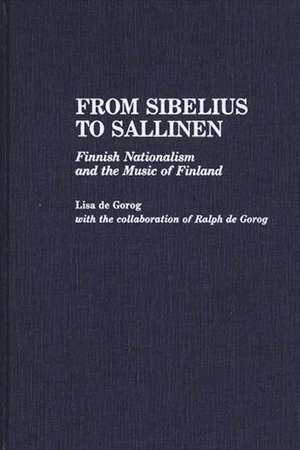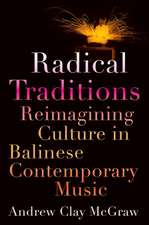From Sibelius to Sallinen: Finnish Nationalism and the Music of Finland: Bibliographies and Indexes in Sociology, cartea 16
Autor Lisa S. De Gorogen Limba Engleză Hardback – 30 noi 1989
This comprehensive study of the evolution of Finnish art music from continental predecessors and native folk music traces the development of Sibelius's musical language from his first major work, "Kullervo," the first genuine Finnish recitative, to the last tone poem, "Tapiola." De Gorog asserts the importance of "En Saga," Sibelius's first major, purely orchestral work, as a composition that affirms the composer's belief in both rhythm and in the variation method (the germ motif technique). The impact of folk music on the germ motif technique as well as on melody, phrase construction, and harmony are also analyzed. Although Sibelius's use of rhythm was more restrained than that of Bartok, Stravinsky, or Prokofiev, similarities in basic trends and folk music influences are noted by de Gorog. From Sibelius to Sallinen emphasizes the importance of various aspects of Finnish culture, the historical events that shaped that culture, and Finnish nationalism in the evolution of Finnish music in general. It also delineates the major sources of inspiration for Sibelius's unique musical idiom. The volume clarifies Sibelius's position as founder of Finnish art music and considers the evolution of trends established by him in the works of younger Finnish composers.
The first three chapters provide an historical prism through which to view Finnish culture and music, discuss Finnish music prior to Sibelius, and relate Finnish nationalism to the composer's philosophy and music. Chapters 4 through 7 focus on Sibelius, his compositions, and their lasting impact. Two final chapters address instrumental music after Sibelius and stage and vocal music in Finland. A discography provides ready access and full information on the works and completes the volume as an informative resource for students, teachers, researchers, musicologists, and performers as well as a valuable addition to university music libraries and conservatories.
Preț: 438.59 lei
Preț vechi: 604.64 lei
-27% Nou
83.92€ • 87.45$ • 69.49£
Carte tipărită la comandă
Livrare economică 03-17 aprilie
Specificații
ISBN-10: 0313267405
Pagini: 261
Dimensiuni: 156 x 242 x 24 mm
Greutate: 0.56 kg
Ediția:New.
Editura: Praeger
Seria Bibliographies and Indexes in Sociology
Descriere
The first three chapters provide an historical prism through which to view Finnish culture and music, discuss Finnish music prior to Sibelius, and relate Finnish nationalism to the composer's philosophy and music. Chapters 4 through 7 focus on Sibelius, his compositions, and their lasting impact. Two final chapters address instrumental music after Sibelius and stage and vocal music in Finland. A discography provides ready access and full information on the works and completes the volume as an informative resource for students, teachers, researchers, musicologists, and performers as well as a valuable addition to university music libraries and conservatories.

























